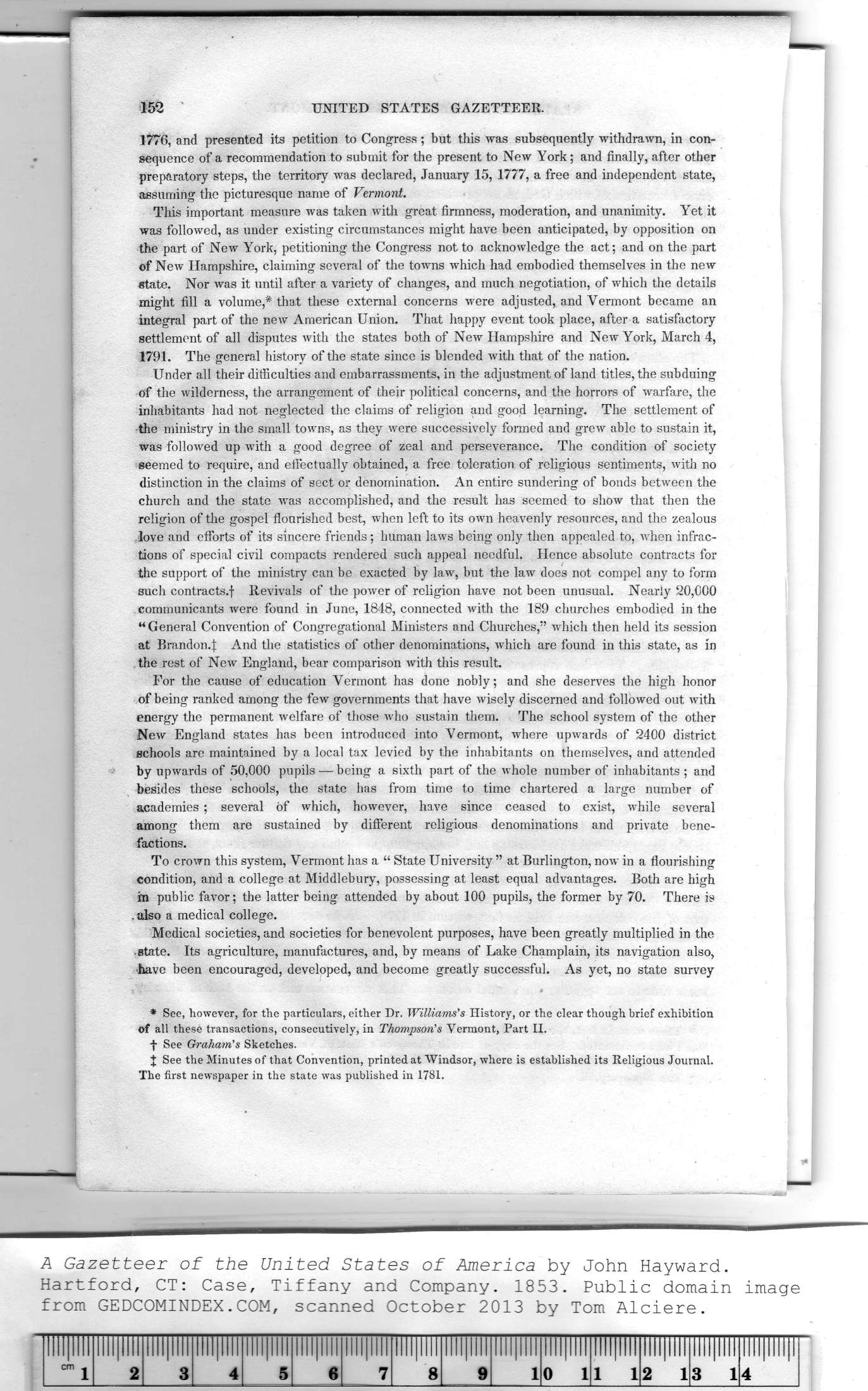|
|
Note: Ctrl and + increases the font size of the text below, Ctrl and - decreases it, and Ctrl and 0 resets it to default size.
im UNITED STATES GAZETTEER.
1776, and presented its petition to Congress; but this was subsequently withdrawn, in con-
sequence of a recommendation to submit for the present to New York; and finally, after other
preparatory steps, the territory was declared, January 15, 1777, a free and independent state,
assuming the picturesque name of Vermont.
This important measure was taken with great firmness, moderation, and unanimity. Yet it
was followed, as under existing circumstances might have been anticipated, by opposition on
the part of New York, petitioning the Congress not to acknowledge the act; and on the part
of New Hampshire, claiming several of the towns which had embodied themselves in the new
state. Nor was it until after a variety of changes, and much negotiation, of which the details
might fill a volume,1 that these external concerns were adjusted, and Vermont became an
integral part of the new American Union. That happy event took place, after a satisfactory
settlement of all disputes with the states both of New Hampshire and New York, March 4,
1791. The general history of the state since is blended with that of the nation.
Under all their difficulties and embarrassments, in the adjustment of land titles, the subduing
of the wilderness, the arrangement of their political concerns, and the horrors of warfare, the
inhabitants had not neglected the claims of religion and good learning. The settlement of
the ministry in the small towns, as they were successively formed and grew able to sustain it,
was followed up with a good degree of zeal and perseverance. The condition of society
seemed to require, and effectually obtained, a free toleration of religious sentiments, with no
distinction in the claims of sect or denomination. An entire sundering of bonds between the
church and the state was accomplished, and the result has seemed to show that then the
religion of the gospel flourished best, when left to its own heavenly resources, and the zealous
love and efforts of its sincere friends; human laws being only then appealed to, when infrac-
tions of special civil compacts rendered such appeal needful. Hence absolute contracts for
the support of the ministry can be exacted by law, but the law does not compel any to form
such contracts.f Revivals of the power of religion have not been unusual. Nearly 20,000
communicants were found in June, 1848, connected with the 189 churches embodied in the
“ General Convention of Congregational Ministers and Churches," which then held its session
at Brandon.j; And the statistics of other denominations, which are found in this state, as in
the rest of New England, bear comparison with this result.
For the cause of education Vermont has done nobly; and she deserves the high honor
of being ranked among the few governments that have wisely discerned and followed out with
energy the permanent welfare of those who sustain them. The school system of the other
New England states has been introduced into Vermont, where upwards of 2400 district
schools are maintained by a local tax levied by the inhabitants on themselves, and attended
by upwards of 50,000 pupils — being a sixth part of the whole number of inhabitants ; and
besides these schools, the state has from time to time chartered a large number of
academies ; several of which, however, have since ceased to exist, while several
among them are sustained by different religious denominations and private bene-
factions.
To crown this system, Vermont has a “ State University " at Burlington, now in a flourishing
condition, and a college at Middlebury, possessing at least equal advantages. Both are high
in public favor; the latter being attended by about 100 pupils, the former by 70. There is
. also a medical college.
Medical societies, and societies for benevolent purposes, have been greatly multiplied in the
state. Its agriculture, manufactures, and, by means of Lake Champlain, its navigation also,
■have been encouraged, developed, and become greatly successful. As yet, no state survey
A Gazetteer of the United States of America by John Hayward.
Hartford, CT: Case, Tiffany and Company. 1853. Public domain
1
See, however, for the particulars, either Dr. Williams's History, or the clear though brief exhibition
of all these transactions, consecutively, in Thompson's Vermont, Part II.
f See Graham's Sketches.
J See the Minutes of that Convention, printed at Windsor, where is established its Religious Journal.
The first newspaper in the state was published in 1781.
|
